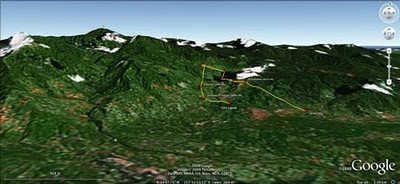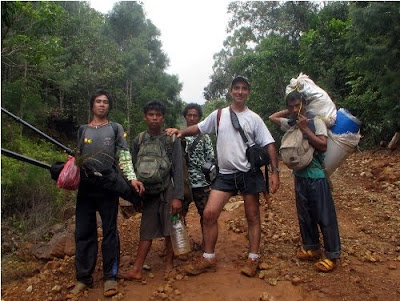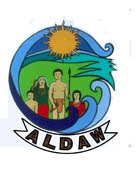The
leathery scent at the venue hall was nothing more than the confirmation that we were working in rural Ethiopia, in a village called Telecho, some 30 kilometres north of Holeta. We had just gathered with 20 delegates coming from Ethiopia, Kenya, Tanzania, South Africa, Uganda, Cameroon and Benin to co-facilitate a participatory mapping exercise implemented by more than 130 villagers coming from 28 kebeles located within the area and foothills of a mountain known as Foata.

The exercise – organised by
MELCA-Ethiopia, a national NGO and supported by the Technical Centre for Agricultural and Rural Cooperation ACP-EU (
CTA), was a response to a call by the community for assistance in rehabilitating its environment which suffered heavy deforestation and soil degradation over the past decades. After several month of preparation, the exercise took place on 8-18 December 2010 in the village of Telecho amidst a golden landscape shimmering with wheat, teff and rye at maturity stage intersected by dark brown strips of ploughed land and exposed soil cloths weltering in the choking sun.

Close to 140 people worked in shifts on the model which covers – at a 1:10,000-scale - a total area of 672 sq km including portions of four woredas namely Welmera, Ejere, Adea berga and Mulo. Assisted by the trainers, 14 students, three teachers and the foreign delegates (the trainees) manufactured the blank model. Approximately 110 elders representing 28 kebeles contributed in overlapping groups to the elaboration of the map legend and the depicting of their mental maps onto the model. A number of representatives from local government units contributed to the exercise as well.
The assembling of the blank model using 3-mm thick sheets of carton board and measuring 2.8m x 2.4m, took three days while the depiction of the landscape and the location of features relevant to the community, took additional six days.

Selected elders introduced the first group of participants to the draft legend which was verified and further enriched in terms of items and their descriptors. Once completed, the model stored 48 layers of information including 25 point-, 5 line- and 18 area types. A count of point data done at the end of the exercise revealed that within the area there were 38 schools, 23 health posts, 113 sacred trees, 8 markets, 861 settlements and much more.

In terms of process, villagers from the first group introduced the second group to its task and the latter did the same with the third group. This ensured a full transfer of ownership of the entire process from the facilitators, who kick-started the process, to the informants, which proudly presented their output to the wider community and government representatives on the day of the inauguration and closing ceremony. Villagers worked with great attention and passion while depicting the landscape of their woredas. Animated discussions, exchanges, and negotiations characterised the process involving both men (the majority) and women. Traditional dances animated the start of the activities in the morning while work kept on rolling until night at the light of a generator.

A bull was slaughtered in anticipation of the closing ceremony which took place on 18 December 2010. The event signified the apotheosis of the process where elders (man and women) presented the legend and information featured on the 3D model and described the process which led to its production. The audience was composed of approximately 300 villagers originating from all 28 woredas, representatives from the parliament, local government, CTA, the Finnish Embassy and delegates coming from 9 African countries, representing NGOs and universities.

During the various phases of model making, participants were given the chance to express themselves and provide written feedback on the process using so called “democracy walls”. Democracy walls are large sheets of craft paper labelled as “I noticed”, “I learned”, “I discovered”, “I felt”, “I would like to suggest” where individuals can stick A5 sheets of paper where they have marked a statement related to the “label” and concerning the process experienced. In addition a professional media team documented the process and conducted interviews, and a group of youth was trained and assisted in producing a Participatory Video (PV).

Participating villagers reported that working on the model elicited powerful memories of a past landscape characterised by lush forests and permanent river courses, and made them realise how much the conversion of the matural habitat had impacted (negatively) on their life. Participants stated that through a self-reflection process they realised that their non-sustainable handling of the resources base had led to impoverishment of soils and decrease in crop yield, and that the present situation was threatening their livelihoods and mere subsistence. They stated that the process of model building created learning environment and gave them a sense of purpose. “The P3DM process enables the community to look at itself using the model as a mirror” wrote a villager on a card featuring on the “
Democracy Walls”.
Written statements made by villagers (in Amharic) while working on the 3D model:
“I felt that - as we destroyed the natural resources in our surroundings, we lost the soil, the forest, wild animals and more. This in turn is harming ourselves and creating problems to coming generations”.
“I felt that I could compare what we did on the map with what existed in the past [in the real world], and this makes it clearer about what to do in the future”.
“I noticed that it [the process] helped me understanding the importance of participation. I also realized that the community has valuable knowledge that we were not aware of.”
“I noticed that the P3DM process enables the community to look at itself using the model as a mirror. It builds capacities and that is important for the development of the country.”
Source: Democracy Walls, Telecho, 17 December 2010
The large gathering on 18 December reinforced the message as villagers involved in the mapmaking shared their realisations, increased awareness and statements of intentions. The presence of Government representatives who seemed bewildered by the view of the model at its unveiling, was much appreciated by the community members, and reinforced their perception of being considered and listen to in their pledge for working jointly for a better future. In this context villagers decided to convene a larger meeting to look into a series of actions which would help them rehabilitate their degraded land.

A few days after the completion of the exercise, MELCA was granted additional financial support by the Finnish Embassy to sustain follow-up activities related to the rehabilitation of the environment in the project area. The 3D model will play an important part in this process as it represents the most updated and most relevant repository of local spatial information and a planning tool which can be easily mastered at village level, as it is fully understood and endorsed by the local populace.
Last but not least, the national and international trainees expressed their intention to replicate the process in their areas.
Authors: Giacomo Rambaldi / CTA and Million Belay MELCA-Ethiopia
Images: G. Rambaldi / CTA© and Damian Prestidge / CTA©




















